Harold Ernest Robinson was an American botanist and entomologist.

Stegnosperma is a genus of flowering plants, consisting of three species of woody plants, native to the Caribbean, Central America, and the Sonoran Desert. These are shrubs or lianas, with anomalous secondary thickening in mature stems, by successive cambia.
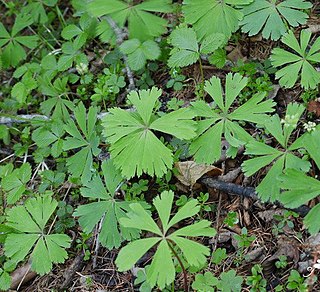
Kingdonia uniflora is a species of perennial herb native to China. The plants have one leaf and a 100-millimetre (4-inch) flower stalk with a 8 mm flower.

Phytolaccaceae is a family of flowering plants. Though almost universally recognized by taxonomists, its circumscription has varied. It is also known as the Pokeweed family.
Hoplestigma is a genus of flowering plants in the family Boraginaceae, although this is disputed, and it has been placed in its own family Hoplestigmataceae. Its two species are native to Cameroon, Gabon, Ivory Coast and Liberia in western tropical Africa.

Tournefortia, often called soldierbushes, is a genus of flowering plants in the borage family, Boraginaceae.

Caryophyllales is a diverse and heterogeneous order of flowering plants that includes the cacti, carnations, amaranths, ice plants, beets, and many carnivorous plants. Many members are succulent, having fleshy stems or leaves. The betalain pigments are unique in plants of this order and occur in all its families with the exception of Caryophyllaceae and Molluginaceae.
Anton Heimerl was an Austrian botanist.

Petiveriaceae is a family of flowering plants formerly included as subfamily Rivinoideae in Phytolaccaceae. The family comprises nine genera, with about 20 known species.

Phaulothamnus is a genus of plants formerly included in the family Phytolaccaceae but now considered a part of the Achatocarpaceae.
Joan W. Nowicke is an American botanist from St. Louis, Missouri. She worked 27 years for the Smithsonian Institution, between 1972 and 1999, in the Department of Botany, from the National Museum of Natural History. Nowicke is a global reference as a palynologist, mainly due to her specialization in pollen morphology and its relationship with systematics, in addition to her extensive work in the area of Caryophyllales palynotaxonomy.
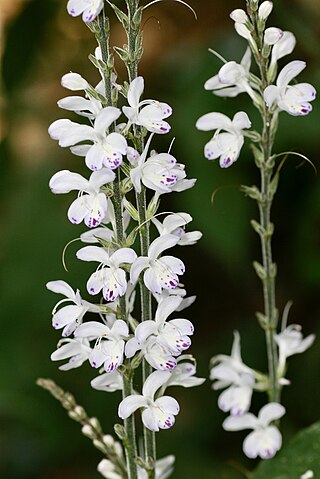
Pulchranthus is a genus of flowering plants belonging to the family Acanthaceae. It includes four species native to northern South America, ranging from Colombia to Bolivia and northern Brazil.
Nowickea is a genus of flowering plants belonging to the family Phytolaccaceae.
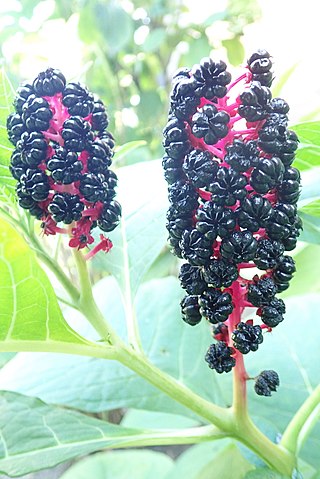
Phytolacca acinosa, the Indian pokeweed, is a species of flowering plant in the family Phytolaccaceae. It is native to temperate eastern Asia; the Himalayas, most of China, Vietnam to Japan, and has been widely introduced to Europe. The species was originally described by William Roxburgh in 1814.
Schindleria is a genus of flowering plants in the family Petiveriaceae.
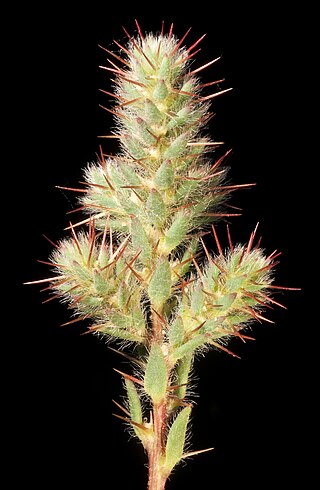
Sclerolaena densiflora is a species of flowering plant in the family Amaranthaceae, native to Western Australia. It was first described in 1904 by William Vincent Fitzgerald as Bassia densiflora, but was transferred to the genus, Sclerolaena in 1978 by Andrew John Scott.

Sclerolaena eurotioides is a species of flowering plant in the family Amaranthaceae, native to Western Australia. It was first described in 1869 by Ferdinand von Mueller as Echinopsilon eurotioides, but was transferred to the genus, Sclerolaena in 1978 by Andrew John Scott.

Sclerolaena hostilis is a species of flowering plant in the family Amaranthaceae, native to Western Australia. It was first described in 1904 by Ludwig Diels as Bassia hostilis, but was transferred to the genus, Sclerolaena in 1921 by Karel Domin.
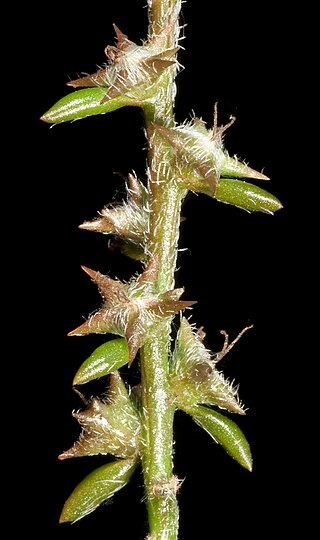
Sclerolaena parviflora is a species of flowering plant in the family Amaranthaceae, found in every mainland state and territory of Australia. It was first described in 1923 by Robert Henry Anderson as Bassia parviflora, but was transferred to the genus, Sclerolaena in 1978 by Andrew John Scott.












